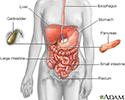Belching
Burping; Eructation; Gas - belchingBelching is the act of bringing up air from the stomach.
Considerations
Belching is a normal process. The purpose of belching is to release air from the stomach. Every time you swallow, you also swallow air, along with fluid or food.
The buildup of air in the upper stomach causes the stomach to stretch. This triggers the muscle at the lower end of the esophagus (the tube that runs from your mouth to the stomach) to relax. Air is allowed to escape up the esophagus and out the mouth.
Depending on the cause of the belching, it may occur more often, last longer, be more forceful.
Symptoms such as nausea, dyspepsia, and heartburn may be relieved by belching.
Dyspepsia
Indigestion (dyspepsia) is a mild discomfort in the upper belly or abdomen. It often occurs during or right after eating. It may feel like:Heat, bu...

Heartburn
Heartburn is a painful burning feeling just below or behind the breastbone. Most of the time, it comes from the esophagus. The pain often rises in ...

Causes
Abnormal belching may be due to:
-
Acid reflux disease (also called gastroesophageal reflux disease or GERD)
Acid reflux disease
Gastroesophageal reflux disease (GERD) is a condition in which the stomach contents leak backward from the stomach into the esophagus (food pipe). F...
 ImageRead Article Now Book Mark Article
ImageRead Article Now Book Mark Article - Digestive system disease
- Pressure caused by the unconscious swallowing of air (aerophagia)
Home Care
You can get relief by lying on your side or in a knee-to-chest position until the gas passes.
Avoid chewing gum, eating quickly, and eating gas-producing foods and beverages.
When to Contact a Medical Professional
Most of the time belching is a minor problem. Contact a health care provider if the belching does not go away, or if you also have other symptoms such as abdominal pain or fever.
What to Expect at Your Office Visit
Your provider will examine you and ask about your medical history and symptoms, including:
- Is this the first time this has occurred?
- Is there a pattern to your belching? For example, does it happen when you are nervous or after you have been consuming certain foods or drinks?
- What other symptoms do you have?
You may need more tests based on what the provider finds during your exam and your other symptoms.
References
McQuaid KR. Approach to the patient with gastrointestinal disease. In: Goldman L, Cooney KA, eds. Goldman-Cecil Medicine. 27th ed. Philadelphia, PA: Elsevier; 2024:chap 118.
Richter JE, Vaezi MF . Gastroesophageal reflux disease. In: Feldman M, Friedman LS, Brandt LJ, eds. Sleisenger and Fordtran's Gastrointestinal and Liver Disease. 11th ed. Philadelphia, PA: Elsevier; 2021:chap 46.
-
Digestive system - illustration
The esophagus, stomach, large and small intestine, aided by the liver, gallbladder and pancreas convert the nutritive components of food into energy and break down the non-nutritive components into waste to be excreted.
Digestive system
illustration
Review Date: 7/8/2023
Reviewed By: Linda J. Vorvick, MD, Clinical Professor, Department of Family Medicine, UW Medicine, School of Medicine, University of Washington, Seattle, WA. Also reviewed by David C. Dugdale, MD, Medical Director, Brenda Conaway, Editorial Director, and the A.D.A.M. Editorial team.



